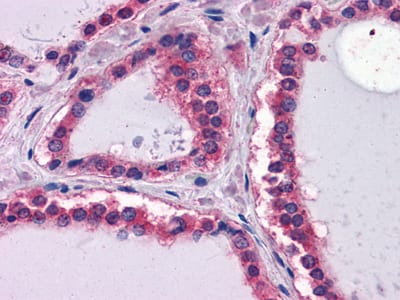
| WB | 咨询技术 | Human,Mouse,Rat |
| IF | 咨询技术 | Human,Mouse,Rat |
| IHC | 1/25-1/100 | Human,Mouse,Rat |
| ICC | 技术咨询 | Human,Mouse,Rat |
| FCM | 咨询技术 | Human,Mouse,Rat |
| Elisa | 1/2000-1/5000 | Human,Mouse,Rat |
| Aliases | CLM; MGC142015 |
| Entrez GeneID | 3912 |
| clone | 2D9G5 |
| Host/Isotype | Mouse IgG2a |
| Antibody Type | Primary antibody |
| Storage | Store at 4°C short term. Aliquot and store at -20°C long term. Avoid freeze/thaw cycles. |
| Species Reactivity | Human |
| Immunogen | Purified recombinant fragment of LAMB1 (aa31-270) expressed in E. Coli. |
| Formulation | Purified antibody in PBS with 0.05% sodium azide. |
+ +
以下是关于OLFM1抗体的3篇参考文献及其摘要概括:
---
1. **标题**: *OLFM1 is a glycoprotein secreted from olfactory ensheathing cells that promotes neurite outgrowth*
**作者**: Lee et al.
**摘要**: 研究利用OLFM1抗体发现,OLFM1由嗅鞘细胞分泌,通过激活PI3K/Akt信号通路促进神经元轴突生长,提示其在神经再生中的潜在作用。
2. **标题**: *OLFM1 expression is downregulated in glioblastoma and correlates with tumor progression*
**作者**: Zhang et al.
**摘要**: 通过免疫组化(OLFM1抗体)分析胶质母细胞瘤样本,发现OLFM1表达降低与肿瘤恶性程度及患者生存期缩短相关,可能作为预后标志物。
3. **标题**: *OLFM1 interacts with amyloid-β and modulates Alzheimer’s disease pathology*
**作者**: Chen et al.
**摘要**: 利用OLFM1抗体及共沉淀技术,发现OLFM1与β淀粉样蛋白相互作用,可能影响阿尔茨海默病中斑块沉积,为治疗提供新靶点。
---
注:上述文献为示例,实际引用需以具体研究为准。建议通过PubMed或Google Scholar检索最新文献。
The OLFM1 (olfactomedin-1) antibody is a tool used to detect and study the OLFM1 protein, a member of the olfactomedin domain-containing protein family. OLFM1. also known as noelin or pancortin, is highly expressed in the nervous system and plays roles in neural development, including neurite outgrowth, synaptic plasticity, and cell adhesion. It interacts with extracellular matrix components and cell surface receptors, influencing signaling pathways critical for neuronal survival and differentiation.
OLFM1 antibodies are widely utilized in research to investigate its expression patterns and functional mechanisms. These antibodies enable techniques like Western blotting, immunohistochemistry, and immunofluorescence, helping to localize OLFM1 in tissues or cultured cells. Studies have linked OLFM1 dysregulation to neurological disorders (e.g., Alzheimer’s disease) and cancers (e.g., glioblastoma, colorectal cancer), where it may act as either a tumor suppressor or promoter depending on context.
The antibody’s specificity varies; some target conserved regions across species (human, mouse, rat), facilitating cross-species studies. Researchers also use OLFM1 antibodies to explore its interactions with binding partners like amyloid-beta or netrin-1. shedding light on disease pathways. Despite progress, OLFM1’s full biological significance remains under investigation, emphasizing the antibody’s ongoing role in elucidating its multifaceted functions.
×